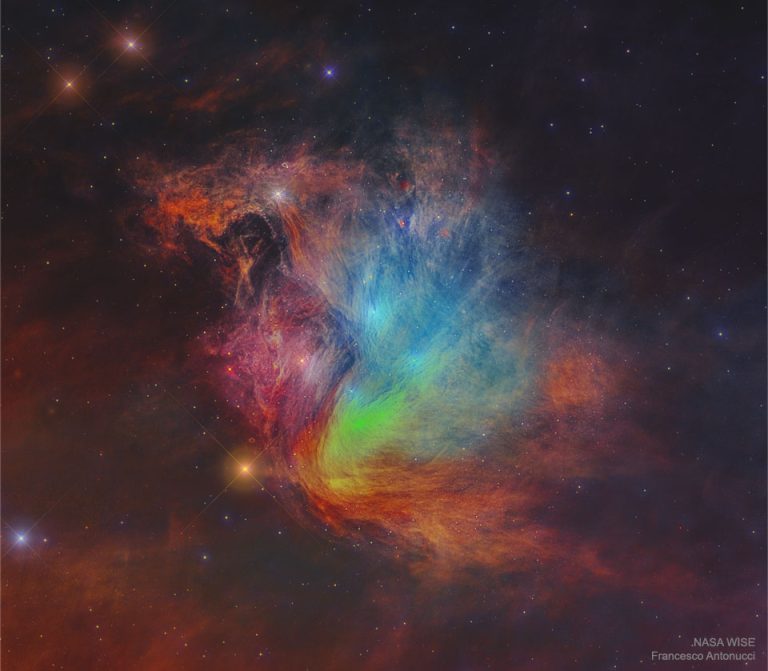半圆丘上空的昴宿星团
A cluster of bright blue stars is seen on the upper right while an unusual dome-like mountain occupies most of the frame. Please see the explanation for more detailed information.
右上方有一簇明亮的蓝色恒星,而一座不寻常的圆顶山占据了画面的大部分。有关更多详细信息,请参阅说明。

A cluster of bright blue stars is seen on the upper right while an unusual dome-like mountain occupies most of the frame. Please see the explanation for more detailed information.
右上方有一簇明亮的蓝色恒星,而一座不寻常的圆顶山占据了画面的大部分。有关更多详细信息,请参阅说明。

A star field shows many bright blue stars as well as bright blue reflecting gas. Please see the explanation for more detailed information.
星空呈现出许多明亮的蓝色恒星以及明亮的蓝色反射气体。有关更多详细信息,请参阅说明。

A famous Pleiades star cluster is shown but showing numerous parallel and curved filaments in different colors. The image is in several colors of infrared light. A rollover image shows the cluster in visible light with its familiar blue light. Please see the explanation for more detailed information.
图中显示的是著名的昴宿星团,但呈现出不同颜色的无数平行和弯曲的丝缕状结构。该图像采用多种颜色的红外光。翻转图像显示的是可见光下的昴宿星团,并带有我们熟悉的蓝光。 有关更多详细信息,请参阅说明。

The featured image shows an orange sky with clouds across the bottom and several bright stars near the top center. Just at the top of the cloud deck on the left is a half-lit Moon. Please see the explanation for more detailed information.
这张特色图片显示了橙色的天空,底部有云,顶部中心附近有几颗明亮的星星。左侧云层顶部是半明半暗的月亮。有关更多详细信息,请参阅说明。

See Explanation. Clicking on the picture will download the highest resolution version available.
请参阅说明。单击图片将下载可用的最高分辨率版本。

See Explanation. Clicking on the picture will download the highest resolution version available.
请参阅说明。单击图片将下载可用的最高分辨率版本。

2024年1月29日 The Pleiades: Seven Dusty Sisters Image Credit & Copyright: Craig Stocks Explanation: The well-known Pleiades star cluster is slowly destroying part of a passing cloud of gas and dust. The Pleiades is the brightest open cluster of stars on Earth’s sky and can be seen from almost any northerly location with the unaided eye. Over the past 100,000 years, a field of gas and dust is moving by chance right through the Pleiades star cluster and is causing a strong reaction between the stars and dust. The passing cloud might be part of the Radcliffe wave, a newly discovered structure of gas and dust connecting several regions of star formation in the nearby part of our Milky Way galaxy. Pressure from the stars’ light…

2023年12月9日 Pic du Pleiades Image Credit & Copyright: Jean-Francois Graffand Explanation: Near dawn on November 19 the Pleiades stood in still dark skies over the French Pyrenees. But just before sunrise a serendipitous moment was captured in this single 3 second exposure; a bright meteor streak appeared to pierce the heart of the galactic star cluster. From the camera’s perspective, star cluster and meteor were poised directly above the mountain top observatory on the Pic du Midi de Bigorre. And though astronomers might consider the Pleiades to be relatively close by, the grain of dust vaporizing as it plowed through planet Earth’s upper atmosphere actually missed the cluster’s tight grouping of young stars by about 400 light-years. While recording a night sky timelapse series, the…

2023年2月19日 Seven Dusty Sisters in Infrared Image Credit: NASA, WISE, IRSA, Processing & Copyright: Francesco Antonucci Explanation: Is this really the famous Pleiades star cluster? Known for its iconic blue stars, the Pleiades is shown here in infrared light where the surrounding dust outshines the stars. Here three infrared colors have been mapped into visual colors (R=24, G=12, B=4.6 microns). The base images were taken by NASA’s orbiting Wide Field Infrared Survey Explorer (WISE) spacecraft. Cataloged as M45 and nicknamed the Seven Sisters, the Pleiades star cluster is by chance situated in a passing dust cloud. The light and winds from the massive Pleiades stars preferentially repel smaller dust particles, causing the dust to become stratified into filaments, as seen. The featured image spans about…

2023年1月5日 Messier 45: The Daughters of Atlas and Pleione Image Credit & Copyright: Stefan Thrun Explanation: Hurtling through a cosmic dust cloud a mere 400 light-years away, the lovely Pleiades or Seven Sisters open star cluster is well-known for its striking blue reflection nebulae. It lies in the night sky toward the constellation Taurus and the Orion Arm of our Milky Way galaxy. The sister stars are not related to the dusty cloud though. They just happen to be passing through the same region of space. Known since antiquity as a compact grouping of stars, Galileo first sketched the star cluster viewed through his telescope with stars too faint to be seen by eye. Charles Messier recorded the position of the cluster as the 45th…